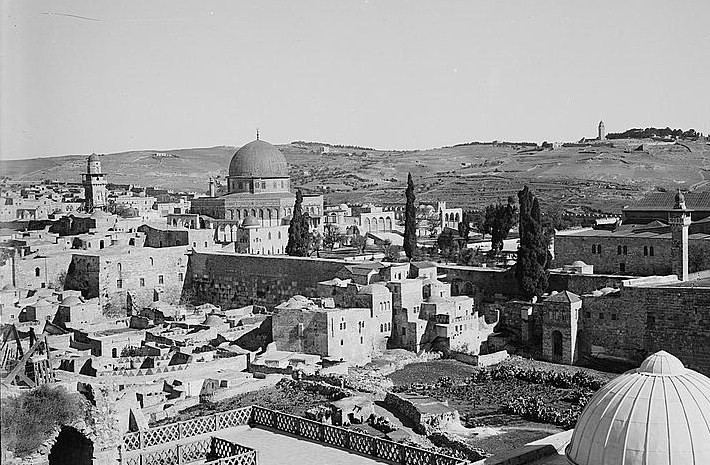 | ||
Moroccan quarter
The Moroccan Quarter or Mughrabi Quarter (Arabic: حارَة المَغارِبة Hārat al-Maghāriba, Hebrew: שכונת המוגרבים, Sh'khunat HaMughrabim) was a 770-year-old neighborhood in the southeast corner of the Old City of Jerusalem, bordering on the western wall of the Temple Mount on the east, the Old City walls on the south (including the Dung Gate) and the Jewish Quarter to the west. It was an extension of the Muslim Quarter to the north, and was founded by a son of Saladin in the late 12th century.
Contents
- Moroccan quarter
- 700 year old moroccan quarter torn down to make place for plaza 1967 jerusalem
- Ayyubid and Mamluk eras
- Ottoman era
- British Mandate era
- Jordanian era
- State of Israel
- References
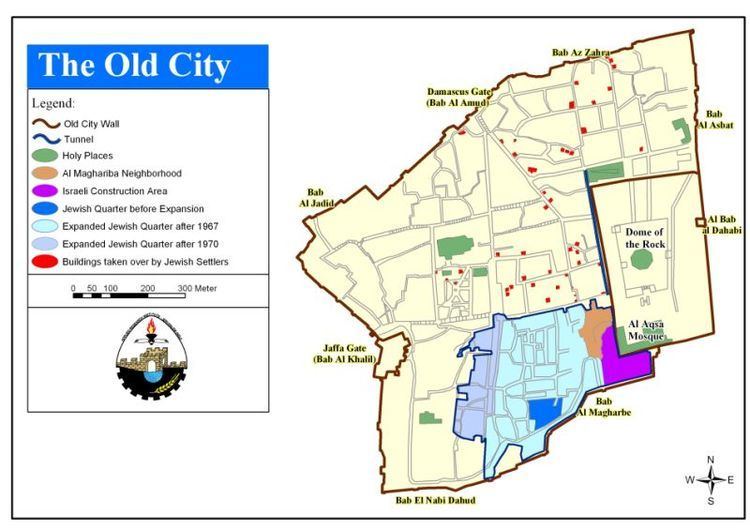
The quarter was razed by Israeli forces three days after the Six-Day War in order to broaden the narrow alley leading to the Western Wall and prepare it for public access by Jews seeking to pray there.
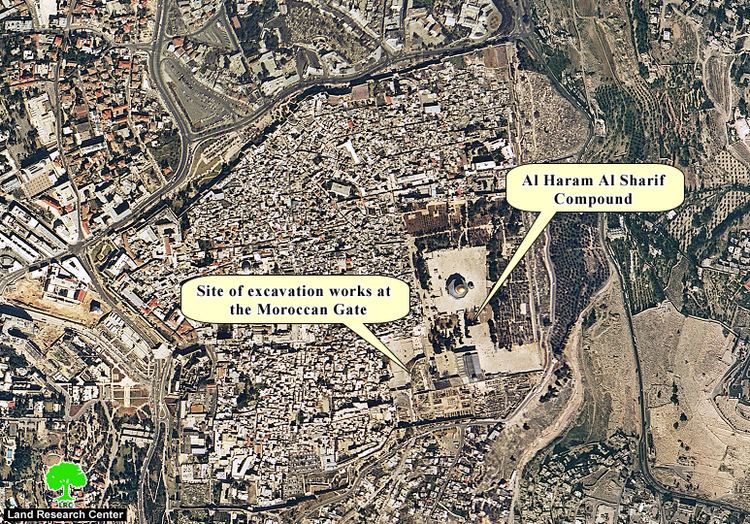
700 year old moroccan quarter torn down to make place for plaza 1967 jerusalem
Ayyubid and Mamluk eras
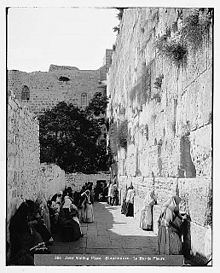
According to the 15th-century historian Mujir ad-Din, the quarter was established in 1193 by Saladin's son al-Malik al-Afdal, as a waqf (charitable trust) dedicated to Moroccan immigrants; he also established a school there, the Afdaliyyah. Later pious Moroccan donors extended this with several other waqfs: in 1303, one Umar ibn Abdullah ibn Abdun-Nabi al-Masmudi al-Mujarrad endowed the al-Masmudia zaouia (religious school) for the benefit of Moroccans living in the Moroccan Quarter, while in 1320 Shuayb ibn Muhammad ibn Shuayb, a grandson of the major Sufi Abu Madyan, endowed a second zaouia there to be funded by his lands at Ain Karim. In 1352, the Marinid sultan of Morocco, Abu Inan Faris, established a smaller waqf—a Qur'an donated to the al-Aqsa Mosque, together with a representative to ensure that it was read from regularly.
Ottoman era
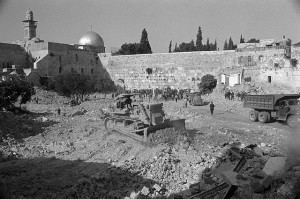
According to the French traveler Chateaubriand who visited in 1806, some of the residents of the quarter were descended from Moors who had been expelled from Spain in the late 15th century. They had been well received by the local community and a mosque had been built for them. Residents of the neighborhood held on to their culture in the way of food, clothing and traditions until it became assimilated with the rest of the Old City in the 19th century. Thus it also became a natural place of stay to Moroccans who came on pilgrimage to the al-Aqsa Mosque.
Taxation registers listed 13 households in the quarter in 1525–26, 69 households, 1 bachelor and 1 imam in 1538–39, 84 households and 11 bachelors in 1553–34, 130 households and 2 bachelors in 1562–63, and 126 households and 7 bachelors in 1596–97.
Over the years a small number of schools, scientific institutions and mosques were established in the quarter and Muslim clerics who performed religious duties at the al-Aqsa Mosque lived there.
Buildings in the quarter were only four meters away from the Wailing Wall (now known as the Western Wall), a remnant of the Second Temple plaza and the holiest most important place of pilgrimage for Jews. Public access to the wall was through a narrow passage from King David's Street, sometimes leading to disputes between the Jewish worshipers, jostling for space, and the residents, who complained of the noise. The Moroccans, who regarded the Jews as infidels, subjected them to harassment and extracted payment in return for allowing them to pray undisturbed.
In an account of his travels to the Holy Land in 1845, T. Tobler noted the existence of a mosque in the Moroccan quarter.
In 1887 an attempt to buy the Moroccan Quarter was made by Baron Rothschild who conceived a plan to purchase the quarter and rebuild it as "a merit and honor to the Jewish People" and to rehouse the inhabitants in better accommodation elsewhere. The proposed purchase was approved by the Ottoman Governor of Jerusalem, Rauf Pasha, and by the Mufti of Jerusalem, Mohammed Tahir Husseini. After permission was obtained from the highest secular and Muslim religious authority to proceed, the plan was shelved because authorities banned any construction there, only permitting the planting of trees to beautify the area. Additionally they would not allow Jews to have full control over the area, as they might ask people to stop using the plaza for various activities that disturbed the worshipers, such as "driving mules." Other reports claim the plan fell through because of speculations that it would trigger a negative Arab reaction.
In the first two months after the Ottoman Empire’s entry into the First World War, the Turkish governor of Jerusalem, Zakey Bey, offered to sell the Moroccan Quarter, which consisted of about 25 houses, to the Jews in order to enlarge the area available to them for prayer. He requested a sum of £20,000 which would be used to both rehouse the Muslim families and to create a public garden in front of the Wall. However, the Jews of the city lacked the necessary funds.
British Mandate era
In 1918, Chaim Weizmann, then a prominent Zionist leader, sent a letter to the Foreign and Commonwealth Office asking for the quarter to be vacated and the wall placed under Jewish ownership; however, the British maintained the status quo ante. The wall as well as the Moroccan Quarter remained Waqf property, while Jews retained their longstanding right to visit it. After the 1929 Palestine riots, Great Britain appointed a commission under the approval of the League of Nations to settle the issue. The Commission again reaffirmed the status quo, while placing certain restrictions on activities, including forbidding Jews from conducting the Yom Kippur prayers, which involved the blowing of the Shofar, and Muslims from carrying out the Zikr ceremony (the playing of music) close to the wall or to cause annoyance to the Jews.
Jordanian era
When Jordanian forces occupied the Old City in the 1948 Arab–Israeli War, 1,500 Jewish residents were expelled from the Jewish Quarter. Both the Jewish quarter and the Moroccan quarter were largely destroyed in the fighting.
In 1965, Palestinian squatters in Jewish properties on the edge of the Moroccan Quarter were evicted by the Jordanian government and resettled in the Shu'afat refugee camp, four kilometers north of the Old City.
State of Israel
On Saturday evening, 10 June 1967, three days after the Israeli army had captured the Old City of Jerusalem, on the last day of the Six Day War, 650 residents of the Moroccan Quarter were told to vacate their homes on short notice. Workers guarded by soldiers first demolished a public lavatory, and then the remaining buildings, which included 135 houses and the Bou Medyan zaouia. Some of the residents refused to leave until their homes were collapsing. An elderly woman discovered in the rubble died soon after.
The Sheikh Eid Mosque, one of the few mosques remaining from the time of Saladin was also destroyed.
The demolition was approved by the Mayor of Jerusalem Teddy Kollek, who wrote about it in his 1978 autobiography. In a letter to the United Nations, the Israeli government stated that the buildings were demolished after the Jordanian government had allowed the neighborhood to become a slum area. The work was done quickly in anticipation of a huge crowd of Jewish worshipers, who would be able to pray at the wall for the first time in 19 years. Lieutenant Colonel Yaakov Salman, the deputy military governor in charge of the operation, aware of possible legal trouble on account of the Geneva Convention, had brought documents from the East Jerusalem municipality testifying to the poor sanitary conditions in the neighborhood and Jordanian plans to eventually evacuate it.
On April 18, 1968, the Israeli government expropriated the land for public use and paid 200 Jordanian dinars to each family that had been displaced. A group of former residents wrote to Kollek to thank him for his assistance in resettling them in better housing conditions.
A complex of buildings close to the wall, that included Madrasa Fakhriya and the house that the Abu al-Sa'ud family had occupied since the 16th century, were spared in the 1967 destruction, but demolished in 1969.
The prayer site was extended southwards to double its length from 28 to 60 meters, and the original plaza of four meters to 40 meters: the small 120 square meter area in front of the wall became the Western Wall Plaza, now in use as an open-air synagogue covering 20,000 square meters.
In the post-1967 period, many of the residents emigrated to Morocco with the assistance of King Hassan II. Other families resettled in the Shu'afat refugee camp and other parts of Jerusalem.
